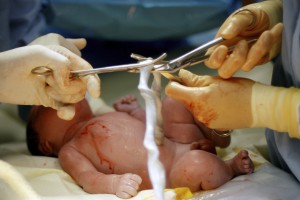
In most hospitals, a newborn’s umbilical cord is clamped within 15-20 seconds after birth. Doctors do this to lessen the possibility of hemorrhaging for the mother. But a review of studies has found that delaying clamping of the cord just a little longer is very beneficial for the baby, and does not appear to increase the risk of severe bleeding (or other complications) for the mother.
The review, published online recently in the Cochrane Database of Systematic Reviews, found that delaying cord-clamping for at least one minute after birth greatly improves iron and hemoglobin levels in newborns (hemoglobin is the protein in red blood cells that carries oxygen to all the tissues and organs; more iron means more hemoglobin will be made). Delaying clamping of the cord allows more blood and its iron to pulsate from the placenta and umbilical cord into the baby.
Read More






